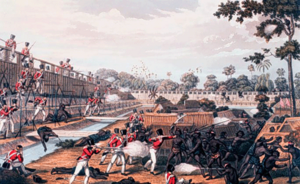First Burmese War
|
First Anglo-Burmese War ပထမ အင်္ဂလိပ် မြန်မာ စစ် |
|||||||||
|---|---|---|---|---|---|---|---|---|---|
 The Storming of one of the principal stockades on its inside, near Rangoon, on 8 July 1824 |
|||||||||
|
|||||||||
| Belligerents | |||||||||
|
|
|
||||||||
| Commanders and leaders | |||||||||
|
Sir Archibald Campbell Joseph Wanton Morrison |
Maha Bandula † Maha Ne Myo † Minkyaw Zeya Thura |
||||||||
| Strength | |||||||||
| 50,000 | 40,000 | ||||||||
| Casualties and losses | |||||||||
| 15,000 | Unknown but significantly higher than the British | ||||||||
British victory
The First Anglo-Burmese War, also known as the First Burma War, (Burmese: ပထမ အင်္ဂလိပ် မြန်မာ စစ်; [pətʰəma̰ ɪ́ɴɡəleiʔ mjəmà sɪʔ]; 5 March 1824 – 24 February 1826) was the first of three wars fought between the British and Burmese empires in the 19th century. The war, which began primarily over the control of Northeastern India, ended in a decisive British victory, giving the British total control of Assam, Manipur, Cachar and Jaintia as well as Arakan Province and Tenasserim. The Burmese were also forced to pay an indemnity of one million pounds sterling, and sign a commercial treaty.
Fifteen thousand European and Indian soldiers died, together with an unknown number of Burmese military and civilian casualties. The high cost of the campaign to the British, 5–13 million pounds sterling (£379 million-£985 million as of 2015), contributed to a severe economic crisis in British India which cost the East India Company its remaining privileges.
...
Wikipedia
